HRM Report: Conflict Resolution, Leadership Principles, Negotiation
VerifiedAdded on 2022/09/30
|16
|4354
|454
Report
AI Summary
This report, prepared for a Human Resource Management course (BUSM4590), examines critical aspects of people and organizations. It delves into conflict management, differentiating between good and bad conflict, providing examples, and outlining the HR manager's role in resolution. The report then explores leadership principles, negotiation processes (distributive and integrative), and motivational theories (process and content). It analyzes communication barriers, the HR manager's role in facilitating effective communication, strategies for promoting ethical culture, and the management of conflicting viewpoints in groupthink. The content is supported by academic literature and aims to provide practical solutions for managing people in organizations, addressing key aspects of HRM, and offering a comprehensive overview of organizational behavior issues.

Running head: HUMAN RESOURCE MANAGEMENT
People and organizational management
Name of the student
Name of the organization
Author Note:
People and organizational management
Name of the student
Name of the organization
Author Note:
Paraphrase This Document
Need a fresh take? Get an instant paraphrase of this document with our AI Paraphraser
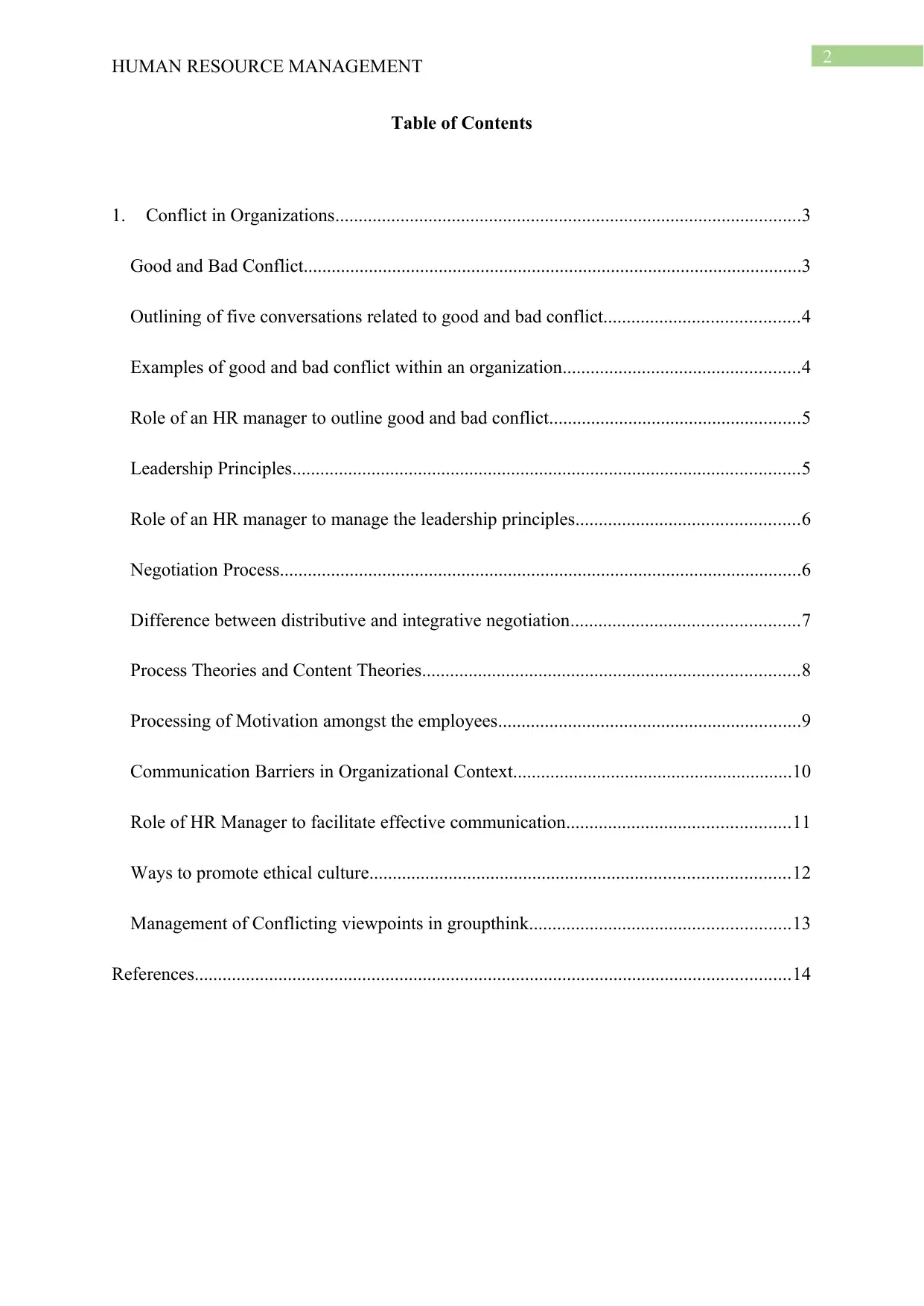
2
HUMAN RESOURCE MANAGEMENT
Table of Contents
1. Conflict in Organizations....................................................................................................3
Good and Bad Conflict...........................................................................................................3
Outlining of five conversations related to good and bad conflict..........................................4
Examples of good and bad conflict within an organization...................................................4
Role of an HR manager to outline good and bad conflict......................................................5
Leadership Principles.............................................................................................................5
Role of an HR manager to manage the leadership principles................................................6
Negotiation Process................................................................................................................6
Difference between distributive and integrative negotiation.................................................7
Process Theories and Content Theories.................................................................................8
Processing of Motivation amongst the employees.................................................................9
Communication Barriers in Organizational Context............................................................10
Role of HR Manager to facilitate effective communication................................................11
Ways to promote ethical culture..........................................................................................12
Management of Conflicting viewpoints in groupthink........................................................13
References................................................................................................................................14
HUMAN RESOURCE MANAGEMENT
Table of Contents
1. Conflict in Organizations....................................................................................................3
Good and Bad Conflict...........................................................................................................3
Outlining of five conversations related to good and bad conflict..........................................4
Examples of good and bad conflict within an organization...................................................4
Role of an HR manager to outline good and bad conflict......................................................5
Leadership Principles.............................................................................................................5
Role of an HR manager to manage the leadership principles................................................6
Negotiation Process................................................................................................................6
Difference between distributive and integrative negotiation.................................................7
Process Theories and Content Theories.................................................................................8
Processing of Motivation amongst the employees.................................................................9
Communication Barriers in Organizational Context............................................................10
Role of HR Manager to facilitate effective communication................................................11
Ways to promote ethical culture..........................................................................................12
Management of Conflicting viewpoints in groupthink........................................................13
References................................................................................................................................14

3
HUMAN RESOURCE MANAGEMENT
1. Conflict in Organizations
Good and Bad Conflict
According to, Toegel and Barsoux (2016) Conflict in workplace is not all related to
shouting, passive aggression, tantrums and unwillingness to work. Conflict in workplace thus
can be different in nature which means that apart from the bad elements of conflict, conflict
situations can also be quite good in nature and it can help improve the productivity of the
business. According to, Bercovitch (2019) Good conflict can act as an ingredient of a healthy
and productive work environment. Good conflict is something that often arises from different
kinds of mutual based commitment towards the goals of the organization and the desire of the
organization to come forward with the ideal business solutions of the organization. This
generally relates to the different kinds of the organizational goals and the need for the
management of the business organization to come up with the ideal solutions. According to,
Toegel and Barsoux (2016) the following activities helps the management of the business to
promote business challenges, interest in the different problems at hand, an increased effort
from all the parties of the business and man more as such. The presence of a good conflict
helps in the improvement of the business communication, support and also increases patience
of the parties involved in the business (Rothman et al. 2017).
On the other hand, Bad conflict generally refers to the different problems or conflict
situations that occur in in the workplace. The conflict maybe within two or more employees
or involves the management and the employees (Rothman et al. 2017). This kind of the
conflict situations hampers the productivity of the organization and also creates a hostile
unpleasant environment. Such an environment will lead to the failure of the organization
accordingly.
HUMAN RESOURCE MANAGEMENT
1. Conflict in Organizations
Good and Bad Conflict
According to, Toegel and Barsoux (2016) Conflict in workplace is not all related to
shouting, passive aggression, tantrums and unwillingness to work. Conflict in workplace thus
can be different in nature which means that apart from the bad elements of conflict, conflict
situations can also be quite good in nature and it can help improve the productivity of the
business. According to, Bercovitch (2019) Good conflict can act as an ingredient of a healthy
and productive work environment. Good conflict is something that often arises from different
kinds of mutual based commitment towards the goals of the organization and the desire of the
organization to come forward with the ideal business solutions of the organization. This
generally relates to the different kinds of the organizational goals and the need for the
management of the business organization to come up with the ideal solutions. According to,
Toegel and Barsoux (2016) the following activities helps the management of the business to
promote business challenges, interest in the different problems at hand, an increased effort
from all the parties of the business and man more as such. The presence of a good conflict
helps in the improvement of the business communication, support and also increases patience
of the parties involved in the business (Rothman et al. 2017).
On the other hand, Bad conflict generally refers to the different problems or conflict
situations that occur in in the workplace. The conflict maybe within two or more employees
or involves the management and the employees (Rothman et al. 2017). This kind of the
conflict situations hampers the productivity of the organization and also creates a hostile
unpleasant environment. Such an environment will lead to the failure of the organization
accordingly.
⊘ This is a preview!⊘
Do you want full access?
Subscribe today to unlock all pages.

Trusted by 1+ million students worldwide

4
HUMAN RESOURCE MANAGEMENT
Outlining of five conversations related to good and bad conflict
Some of the best conversations in good conflict are as follows;
a. Wow, the challenge has led me to a new idea for the business
b. The issue has raised questions to receive solutions for the task
c. Hey I have just cracked an innovative idea that can be implemented easily
d. The change in the company has been because of the different kinds of the conflict
situations
e. Group thinking has been developed through conflict
Some of the best conversations in bad conflict are as follows;
a. How dare you hide the truth from the boss?
b. How can you do such a thing its cheating?
c. You have been behaving roughly with me since a few days and I warn you that you
will face a negative outcome of this.
d. Your argument is baseless and you must say sorry about the same or get ready to face
the consequences
e. Don’t you dare to talk to me like this?
Examples of good and bad conflict within an organization
As said earlier, conflict is an important part in workplace settings and different
conflicts. These situations can occur in the workplace amongst different people like the co-
workers, managers and the management of the organization. According to, Toegel and
Barsoux (2016) any problem in between them can lead to major issues within the business
organization. The example of
ABC Corporation private limited can help to gain an
understanding of the total situation in a proper manner. Some of the bad conflicts generally
HUMAN RESOURCE MANAGEMENT
Outlining of five conversations related to good and bad conflict
Some of the best conversations in good conflict are as follows;
a. Wow, the challenge has led me to a new idea for the business
b. The issue has raised questions to receive solutions for the task
c. Hey I have just cracked an innovative idea that can be implemented easily
d. The change in the company has been because of the different kinds of the conflict
situations
e. Group thinking has been developed through conflict
Some of the best conversations in bad conflict are as follows;
a. How dare you hide the truth from the boss?
b. How can you do such a thing its cheating?
c. You have been behaving roughly with me since a few days and I warn you that you
will face a negative outcome of this.
d. Your argument is baseless and you must say sorry about the same or get ready to face
the consequences
e. Don’t you dare to talk to me like this?
Examples of good and bad conflict within an organization
As said earlier, conflict is an important part in workplace settings and different
conflicts. These situations can occur in the workplace amongst different people like the co-
workers, managers and the management of the organization. According to, Toegel and
Barsoux (2016) any problem in between them can lead to major issues within the business
organization. The example of
ABC Corporation private limited can help to gain an
understanding of the total situation in a proper manner. Some of the bad conflicts generally
Paraphrase This Document
Need a fresh take? Get an instant paraphrase of this document with our AI Paraphraser
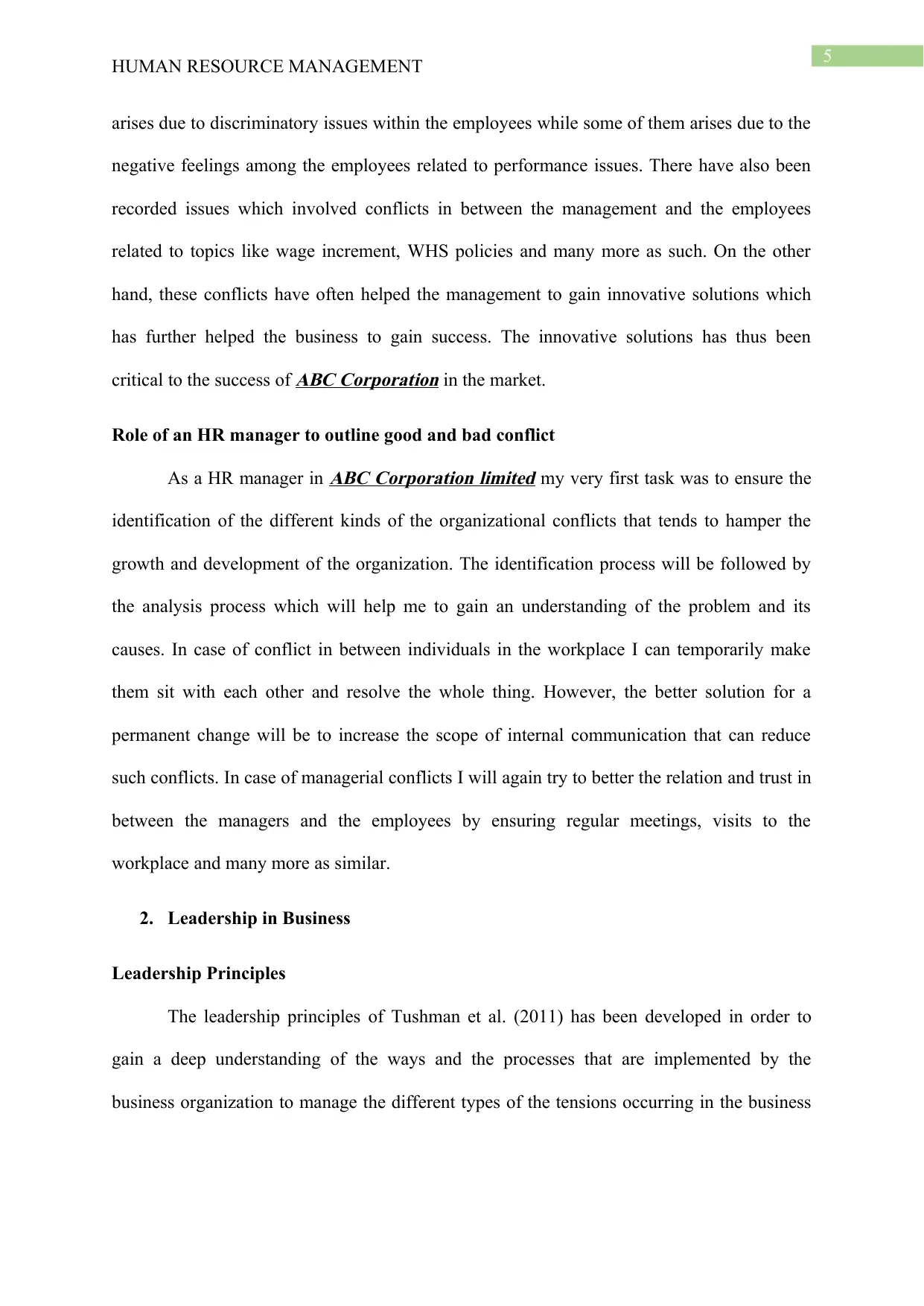
5
HUMAN RESOURCE MANAGEMENT
arises due to discriminatory issues within the employees while some of them arises due to the
negative feelings among the employees related to performance issues. There have also been
recorded issues which involved conflicts in between the management and the employees
related to topics like wage increment, WHS policies and many more as such. On the other
hand, these conflicts have often helped the management to gain innovative solutions which
has further helped the business to gain success. The innovative solutions has thus been
critical to the success of
ABC Corporation in the market.
Role of an HR manager to outline good and bad conflict
As a HR manager in
ABC Corporation limited my very first task was to ensure the
identification of the different kinds of the organizational conflicts that tends to hamper the
growth and development of the organization. The identification process will be followed by
the analysis process which will help me to gain an understanding of the problem and its
causes. In case of conflict in between individuals in the workplace I can temporarily make
them sit with each other and resolve the whole thing. However, the better solution for a
permanent change will be to increase the scope of internal communication that can reduce
such conflicts. In case of managerial conflicts I will again try to better the relation and trust in
between the managers and the employees by ensuring regular meetings, visits to the
workplace and many more as similar.
2. Leadership in Business
Leadership Principles
The leadership principles of Tushman et al. (2011) has been developed in order to
gain a deep understanding of the ways and the processes that are implemented by the
business organization to manage the different types of the tensions occurring in the business
HUMAN RESOURCE MANAGEMENT
arises due to discriminatory issues within the employees while some of them arises due to the
negative feelings among the employees related to performance issues. There have also been
recorded issues which involved conflicts in between the management and the employees
related to topics like wage increment, WHS policies and many more as such. On the other
hand, these conflicts have often helped the management to gain innovative solutions which
has further helped the business to gain success. The innovative solutions has thus been
critical to the success of
ABC Corporation in the market.
Role of an HR manager to outline good and bad conflict
As a HR manager in
ABC Corporation limited my very first task was to ensure the
identification of the different kinds of the organizational conflicts that tends to hamper the
growth and development of the organization. The identification process will be followed by
the analysis process which will help me to gain an understanding of the problem and its
causes. In case of conflict in between individuals in the workplace I can temporarily make
them sit with each other and resolve the whole thing. However, the better solution for a
permanent change will be to increase the scope of internal communication that can reduce
such conflicts. In case of managerial conflicts I will again try to better the relation and trust in
between the managers and the employees by ensuring regular meetings, visits to the
workplace and many more as similar.
2. Leadership in Business
Leadership Principles
The leadership principles of Tushman et al. (2011) has been developed in order to
gain a deep understanding of the ways and the processes that are implemented by the
business organization to manage the different types of the tensions occurring in the business

6
HUMAN RESOURCE MANAGEMENT
organization (Komives 2016). Some of the major leadership principles that has been
discussed here are as follows;
a. Innovation- Innovation is one of the major elements of the business as because it
helps the organization to gain a strong ground in the development of the business
organization. Innovation can be defined as something that helps to put new and better
ideas into practice. The major ideas of innovation needs to be addressed by the leaders
to gain a substantial advantage over the other competitors and make the most of the
organization in a proper and efficient manner. Most of the senior executives of the
organization fail to address the innovation process, and thus lacks in confidence while
implementing innovative principles.
b. Exploration and Exploitation- The theoretical models of the innovation process is
important for the organization to differentiate in between the two process of
innovation. Both the process helps the management to gain success
Role of an HR manager to manage the leadership principles
The HR manager has to develop strong leadership roles to gain a stronghold over the
business. It helps in the development of the organization and its employees. The leadership
skills of the HR manager can also help to select and retain the best talents in the organization.
3. Negotiation
Negotiation Process
The negotiation process in a corporate world is one of the most important ingredient
of the business. The process of negotiation is one of the most important things in business as
because it plays an important role in the success of the organization. The process of
negotiation starts at the very moment when the employee gets a selection call from the
enterprise (Ahammad et al. 2016). The process of negotiation becomes evident at the time
HUMAN RESOURCE MANAGEMENT
organization (Komives 2016). Some of the major leadership principles that has been
discussed here are as follows;
a. Innovation- Innovation is one of the major elements of the business as because it
helps the organization to gain a strong ground in the development of the business
organization. Innovation can be defined as something that helps to put new and better
ideas into practice. The major ideas of innovation needs to be addressed by the leaders
to gain a substantial advantage over the other competitors and make the most of the
organization in a proper and efficient manner. Most of the senior executives of the
organization fail to address the innovation process, and thus lacks in confidence while
implementing innovative principles.
b. Exploration and Exploitation- The theoretical models of the innovation process is
important for the organization to differentiate in between the two process of
innovation. Both the process helps the management to gain success
Role of an HR manager to manage the leadership principles
The HR manager has to develop strong leadership roles to gain a stronghold over the
business. It helps in the development of the organization and its employees. The leadership
skills of the HR manager can also help to select and retain the best talents in the organization.
3. Negotiation
Negotiation Process
The negotiation process in a corporate world is one of the most important ingredient
of the business. The process of negotiation is one of the most important things in business as
because it plays an important role in the success of the organization. The process of
negotiation starts at the very moment when the employee gets a selection call from the
enterprise (Ahammad et al. 2016). The process of negotiation becomes evident at the time
⊘ This is a preview!⊘
Do you want full access?
Subscribe today to unlock all pages.

Trusted by 1+ million students worldwide
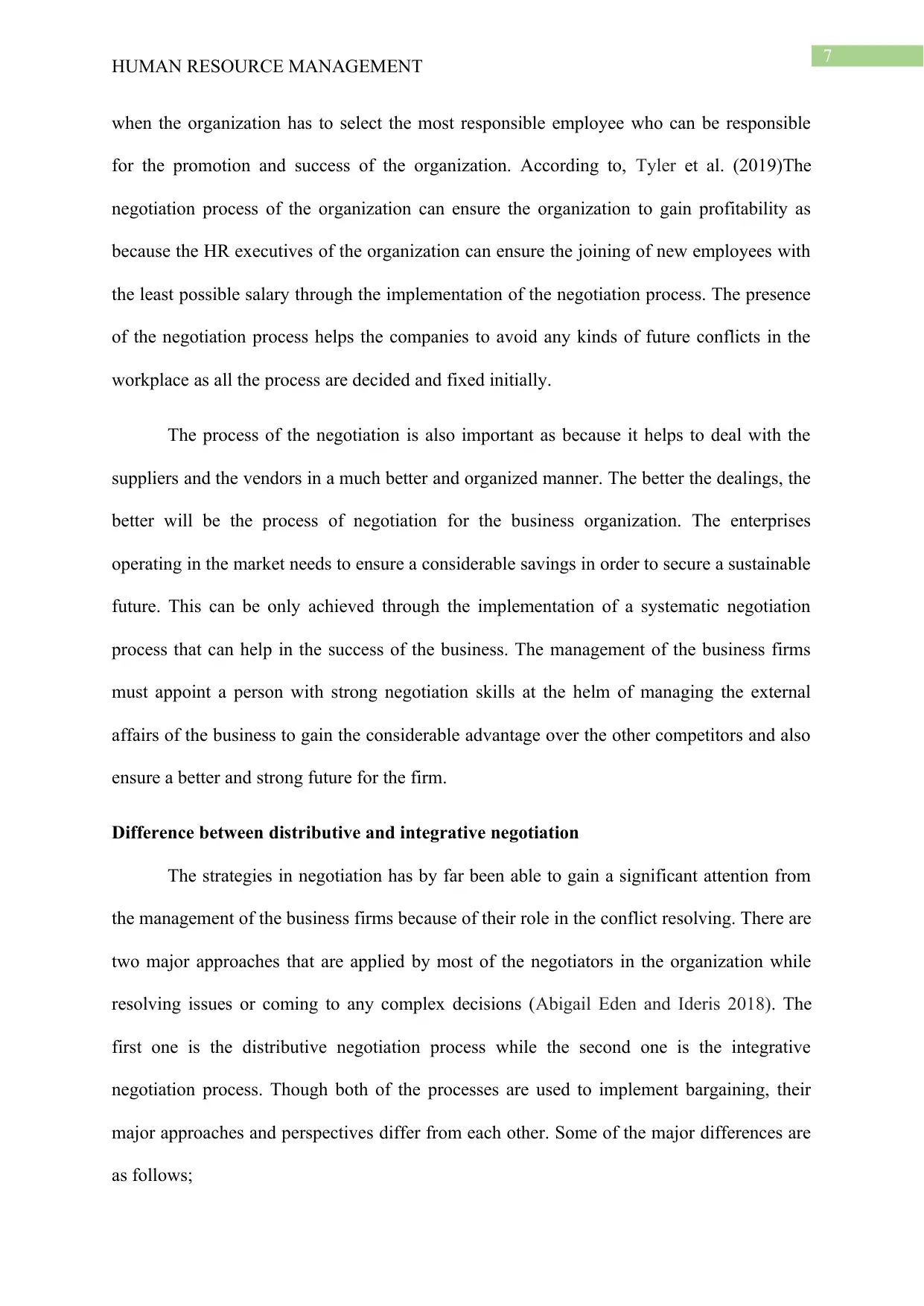
7
HUMAN RESOURCE MANAGEMENT
when the organization has to select the most responsible employee who can be responsible
for the promotion and success of the organization. According to, Tyler et al. (2019)The
negotiation process of the organization can ensure the organization to gain profitability as
because the HR executives of the organization can ensure the joining of new employees with
the least possible salary through the implementation of the negotiation process. The presence
of the negotiation process helps the companies to avoid any kinds of future conflicts in the
workplace as all the process are decided and fixed initially.
The process of the negotiation is also important as because it helps to deal with the
suppliers and the vendors in a much better and organized manner. The better the dealings, the
better will be the process of negotiation for the business organization. The enterprises
operating in the market needs to ensure a considerable savings in order to secure a sustainable
future. This can be only achieved through the implementation of a systematic negotiation
process that can help in the success of the business. The management of the business firms
must appoint a person with strong negotiation skills at the helm of managing the external
affairs of the business to gain the considerable advantage over the other competitors and also
ensure a better and strong future for the firm.
Difference between distributive and integrative negotiation
The strategies in negotiation has by far been able to gain a significant attention from
the management of the business firms because of their role in the conflict resolving. There are
two major approaches that are applied by most of the negotiators in the organization while
resolving issues or coming to any complex decisions (Abigail Eden and Ideris 2018). The
first one is the distributive negotiation process while the second one is the integrative
negotiation process. Though both of the processes are used to implement bargaining, their
major approaches and perspectives differ from each other. Some of the major differences are
as follows;
HUMAN RESOURCE MANAGEMENT
when the organization has to select the most responsible employee who can be responsible
for the promotion and success of the organization. According to, Tyler et al. (2019)The
negotiation process of the organization can ensure the organization to gain profitability as
because the HR executives of the organization can ensure the joining of new employees with
the least possible salary through the implementation of the negotiation process. The presence
of the negotiation process helps the companies to avoid any kinds of future conflicts in the
workplace as all the process are decided and fixed initially.
The process of the negotiation is also important as because it helps to deal with the
suppliers and the vendors in a much better and organized manner. The better the dealings, the
better will be the process of negotiation for the business organization. The enterprises
operating in the market needs to ensure a considerable savings in order to secure a sustainable
future. This can be only achieved through the implementation of a systematic negotiation
process that can help in the success of the business. The management of the business firms
must appoint a person with strong negotiation skills at the helm of managing the external
affairs of the business to gain the considerable advantage over the other competitors and also
ensure a better and strong future for the firm.
Difference between distributive and integrative negotiation
The strategies in negotiation has by far been able to gain a significant attention from
the management of the business firms because of their role in the conflict resolving. There are
two major approaches that are applied by most of the negotiators in the organization while
resolving issues or coming to any complex decisions (Abigail Eden and Ideris 2018). The
first one is the distributive negotiation process while the second one is the integrative
negotiation process. Though both of the processes are used to implement bargaining, their
major approaches and perspectives differ from each other. Some of the major differences are
as follows;
Paraphrase This Document
Need a fresh take? Get an instant paraphrase of this document with our AI Paraphraser
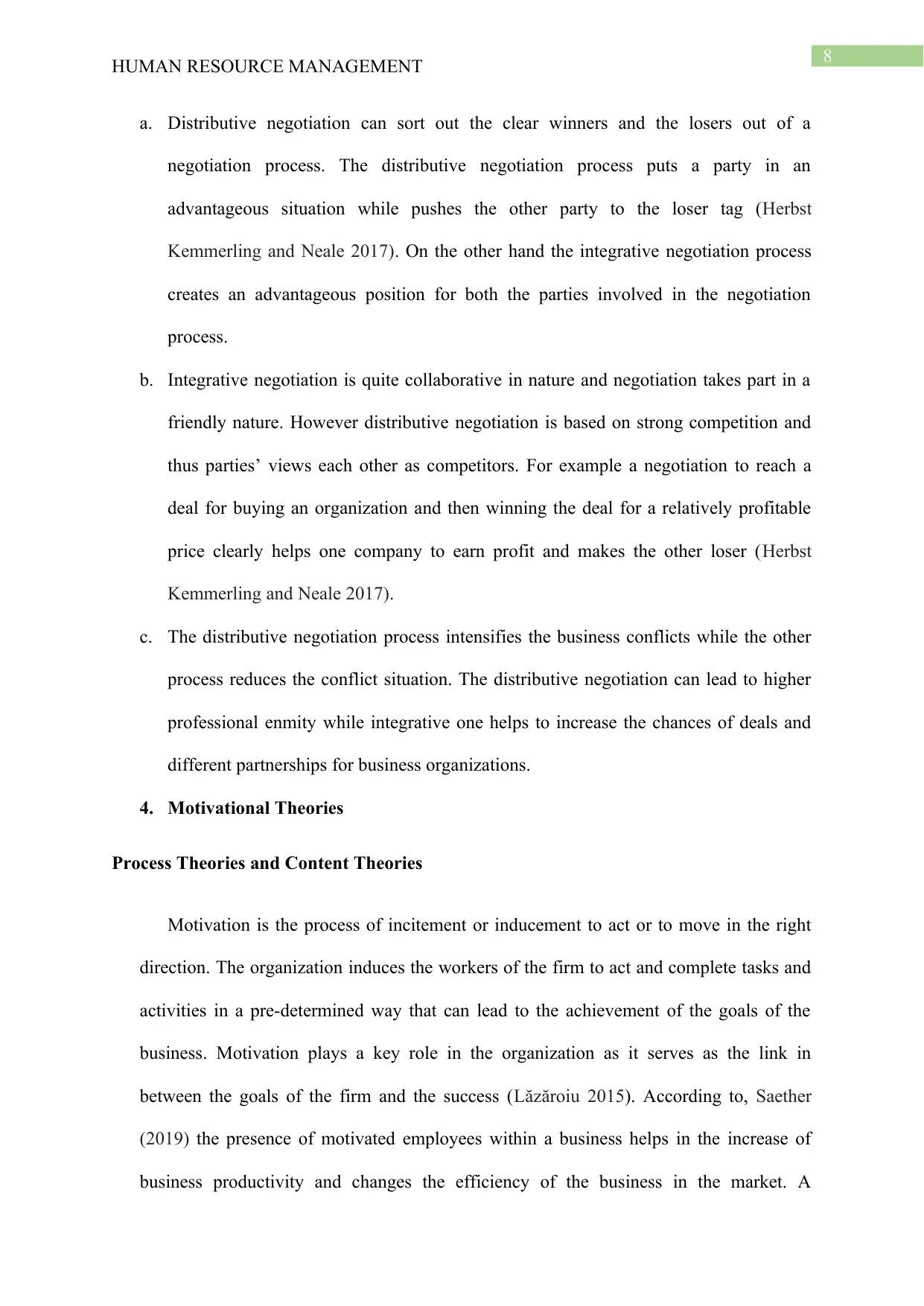
8
HUMAN RESOURCE MANAGEMENT
a. Distributive negotiation can sort out the clear winners and the losers out of a
negotiation process. The distributive negotiation process puts a party in an
advantageous situation while pushes the other party to the loser tag (Herbst
Kemmerling and Neale 2017). On the other hand the integrative negotiation process
creates an advantageous position for both the parties involved in the negotiation
process.
b. Integrative negotiation is quite collaborative in nature and negotiation takes part in a
friendly nature. However distributive negotiation is based on strong competition and
thus parties’ views each other as competitors. For example a negotiation to reach a
deal for buying an organization and then winning the deal for a relatively profitable
price clearly helps one company to earn profit and makes the other loser (Herbst
Kemmerling and Neale 2017).
c. The distributive negotiation process intensifies the business conflicts while the other
process reduces the conflict situation. The distributive negotiation can lead to higher
professional enmity while integrative one helps to increase the chances of deals and
different partnerships for business organizations.
4. Motivational Theories
Process Theories and Content Theories
Motivation is the process of incitement or inducement to act or to move in the right
direction. The organization induces the workers of the firm to act and complete tasks and
activities in a pre-determined way that can lead to the achievement of the goals of the
business. Motivation plays a key role in the organization as it serves as the link in
between the goals of the firm and the success (Lăzăroiu 2015). According to, Saether
(2019) the presence of motivated employees within a business helps in the increase of
business productivity and changes the efficiency of the business in the market. A
HUMAN RESOURCE MANAGEMENT
a. Distributive negotiation can sort out the clear winners and the losers out of a
negotiation process. The distributive negotiation process puts a party in an
advantageous situation while pushes the other party to the loser tag (Herbst
Kemmerling and Neale 2017). On the other hand the integrative negotiation process
creates an advantageous position for both the parties involved in the negotiation
process.
b. Integrative negotiation is quite collaborative in nature and negotiation takes part in a
friendly nature. However distributive negotiation is based on strong competition and
thus parties’ views each other as competitors. For example a negotiation to reach a
deal for buying an organization and then winning the deal for a relatively profitable
price clearly helps one company to earn profit and makes the other loser (Herbst
Kemmerling and Neale 2017).
c. The distributive negotiation process intensifies the business conflicts while the other
process reduces the conflict situation. The distributive negotiation can lead to higher
professional enmity while integrative one helps to increase the chances of deals and
different partnerships for business organizations.
4. Motivational Theories
Process Theories and Content Theories
Motivation is the process of incitement or inducement to act or to move in the right
direction. The organization induces the workers of the firm to act and complete tasks and
activities in a pre-determined way that can lead to the achievement of the goals of the
business. Motivation plays a key role in the organization as it serves as the link in
between the goals of the firm and the success (Lăzăroiu 2015). According to, Saether
(2019) the presence of motivated employees within a business helps in the increase of
business productivity and changes the efficiency of the business in the market. A
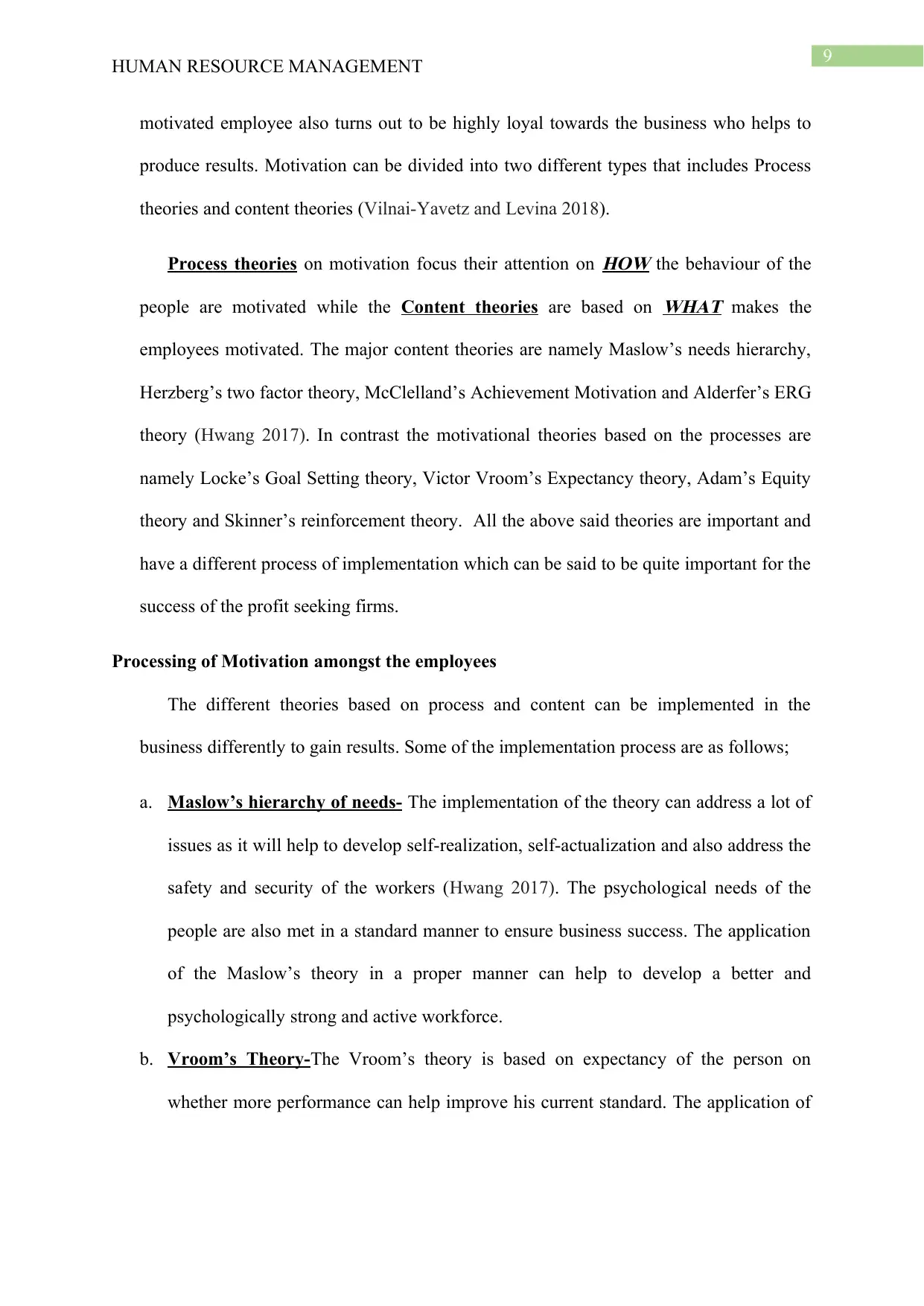
9
HUMAN RESOURCE MANAGEMENT
motivated employee also turns out to be highly loyal towards the business who helps to
produce results. Motivation can be divided into two different types that includes Process
theories and content theories (Vilnai-Yavetz and Levina 2018).
Process theories on motivation focus their attention on
HOW the behaviour of the
people are motivated while the Content theories are based on
WHAT makes the
employees motivated. The major content theories are namely Maslow’s needs hierarchy,
Herzberg’s two factor theory, McClelland’s Achievement Motivation and Alderfer’s ERG
theory (Hwang 2017). In contrast the motivational theories based on the processes are
namely Locke’s Goal Setting theory, Victor Vroom’s Expectancy theory, Adam’s Equity
theory and Skinner’s reinforcement theory. All the above said theories are important and
have a different process of implementation which can be said to be quite important for the
success of the profit seeking firms.
Processing of Motivation amongst the employees
The different theories based on process and content can be implemented in the
business differently to gain results. Some of the implementation process are as follows;
a. Maslow’s hierarchy of needs- The implementation of the theory can address a lot of
issues as it will help to develop self-realization, self-actualization and also address the
safety and security of the workers (Hwang 2017). The psychological needs of the
people are also met in a standard manner to ensure business success. The application
of the Maslow’s theory in a proper manner can help to develop a better and
psychologically strong and active workforce.
b. Vroom’s Theory-The Vroom’s theory is based on expectancy of the person on
whether more performance can help improve his current standard. The application of
HUMAN RESOURCE MANAGEMENT
motivated employee also turns out to be highly loyal towards the business who helps to
produce results. Motivation can be divided into two different types that includes Process
theories and content theories (Vilnai-Yavetz and Levina 2018).
Process theories on motivation focus their attention on
HOW the behaviour of the
people are motivated while the Content theories are based on
WHAT makes the
employees motivated. The major content theories are namely Maslow’s needs hierarchy,
Herzberg’s two factor theory, McClelland’s Achievement Motivation and Alderfer’s ERG
theory (Hwang 2017). In contrast the motivational theories based on the processes are
namely Locke’s Goal Setting theory, Victor Vroom’s Expectancy theory, Adam’s Equity
theory and Skinner’s reinforcement theory. All the above said theories are important and
have a different process of implementation which can be said to be quite important for the
success of the profit seeking firms.
Processing of Motivation amongst the employees
The different theories based on process and content can be implemented in the
business differently to gain results. Some of the implementation process are as follows;
a. Maslow’s hierarchy of needs- The implementation of the theory can address a lot of
issues as it will help to develop self-realization, self-actualization and also address the
safety and security of the workers (Hwang 2017). The psychological needs of the
people are also met in a standard manner to ensure business success. The application
of the Maslow’s theory in a proper manner can help to develop a better and
psychologically strong and active workforce.
b. Vroom’s Theory-The Vroom’s theory is based on expectancy of the person on
whether more performance can help improve his current standard. The application of
⊘ This is a preview!⊘
Do you want full access?
Subscribe today to unlock all pages.

Trusted by 1+ million students worldwide
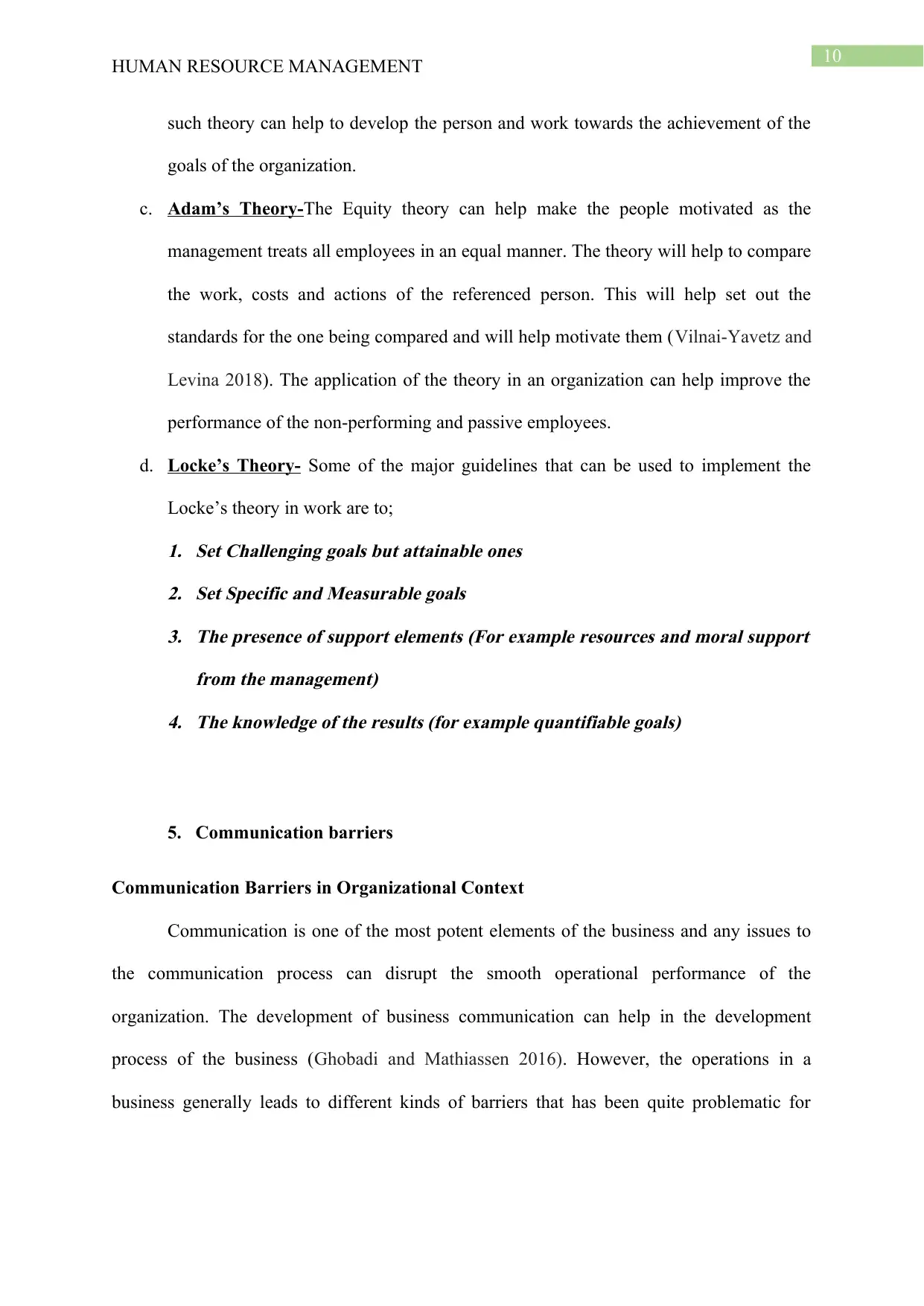
10
HUMAN RESOURCE MANAGEMENT
such theory can help to develop the person and work towards the achievement of the
goals of the organization.
c. Adam’s Theory-The Equity theory can help make the people motivated as the
management treats all employees in an equal manner. The theory will help to compare
the work, costs and actions of the referenced person. This will help set out the
standards for the one being compared and will help motivate them (Vilnai-Yavetz and
Levina 2018). The application of the theory in an organization can help improve the
performance of the non-performing and passive employees.
d. Locke’s Theory- Some of the major guidelines that can be used to implement the
Locke’s theory in work are to;1. Set Challenging goals but attainable ones
2. Set Specific and Measurable goals
3. The presence of support elements (For example resources and moral support
from the management)
4. The knowledge of the results (for example quantifiable goals)
5. Communication barriers
Communication Barriers in Organizational Context
Communication is one of the most potent elements of the business and any issues to
the communication process can disrupt the smooth operational performance of the
organization. The development of business communication can help in the development
process of the business (Ghobadi and Mathiassen 2016). However, the operations in a
business generally leads to different kinds of barriers that has been quite problematic for
HUMAN RESOURCE MANAGEMENT
such theory can help to develop the person and work towards the achievement of the
goals of the organization.
c. Adam’s Theory-The Equity theory can help make the people motivated as the
management treats all employees in an equal manner. The theory will help to compare
the work, costs and actions of the referenced person. This will help set out the
standards for the one being compared and will help motivate them (Vilnai-Yavetz and
Levina 2018). The application of the theory in an organization can help improve the
performance of the non-performing and passive employees.
d. Locke’s Theory- Some of the major guidelines that can be used to implement the
Locke’s theory in work are to;1. Set Challenging goals but attainable ones
2. Set Specific and Measurable goals
3. The presence of support elements (For example resources and moral support
from the management)
4. The knowledge of the results (for example quantifiable goals)
5. Communication barriers
Communication Barriers in Organizational Context
Communication is one of the most potent elements of the business and any issues to
the communication process can disrupt the smooth operational performance of the
organization. The development of business communication can help in the development
process of the business (Ghobadi and Mathiassen 2016). However, the operations in a
business generally leads to different kinds of barriers that has been quite problematic for
Paraphrase This Document
Need a fresh take? Get an instant paraphrase of this document with our AI Paraphraser
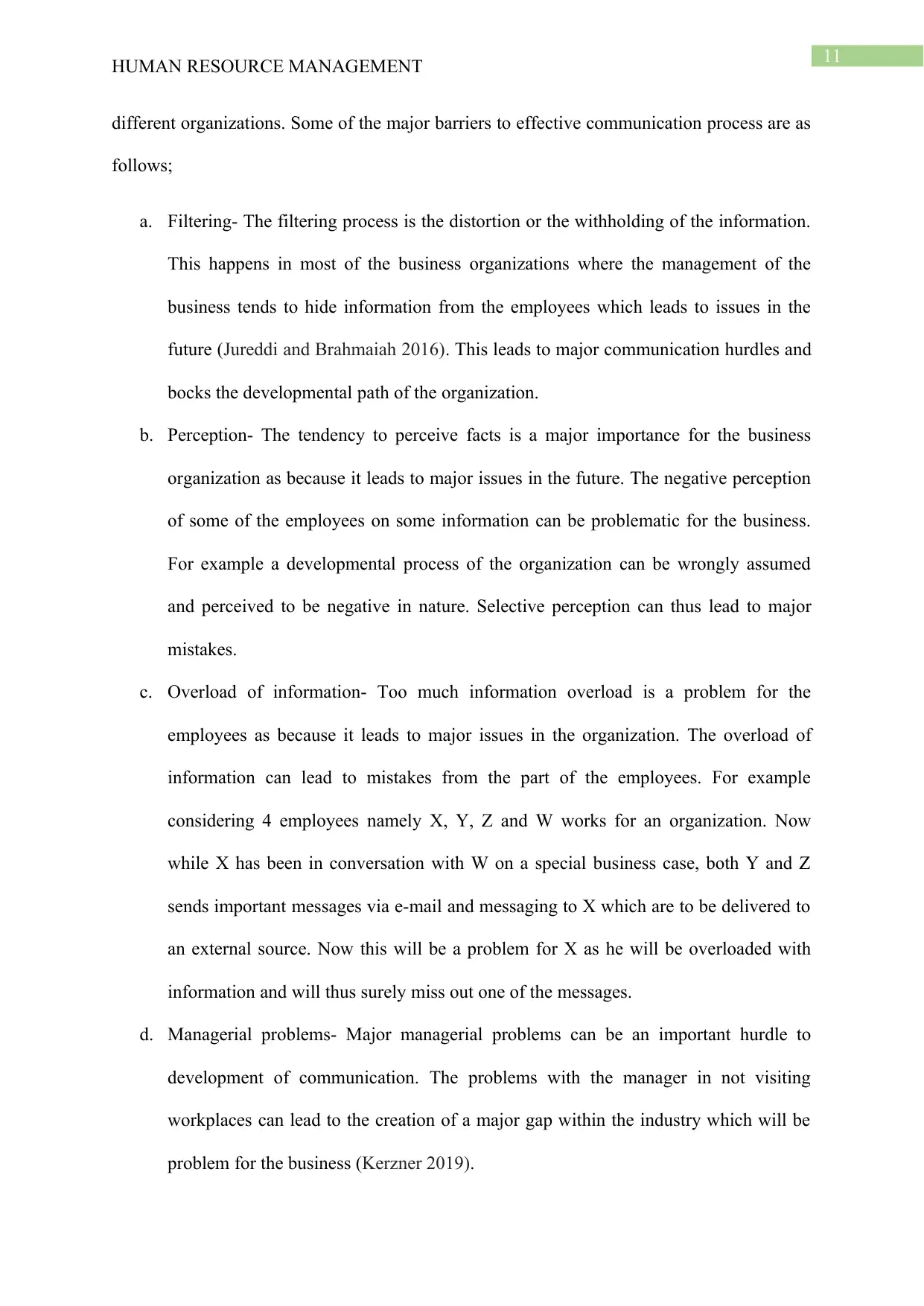
11
HUMAN RESOURCE MANAGEMENT
different organizations. Some of the major barriers to effective communication process are as
follows;
a. Filtering- The filtering process is the distortion or the withholding of the information.
This happens in most of the business organizations where the management of the
business tends to hide information from the employees which leads to issues in the
future (Jureddi and Brahmaiah 2016). This leads to major communication hurdles and
bocks the developmental path of the organization.
b. Perception- The tendency to perceive facts is a major importance for the business
organization as because it leads to major issues in the future. The negative perception
of some of the employees on some information can be problematic for the business.
For example a developmental process of the organization can be wrongly assumed
and perceived to be negative in nature. Selective perception can thus lead to major
mistakes.
c. Overload of information- Too much information overload is a problem for the
employees as because it leads to major issues in the organization. The overload of
information can lead to mistakes from the part of the employees. For example
considering 4 employees namely X, Y, Z and W works for an organization. Now
while X has been in conversation with W on a special business case, both Y and Z
sends important messages via e-mail and messaging to X which are to be delivered to
an external source. Now this will be a problem for X as he will be overloaded with
information and will thus surely miss out one of the messages.
d. Managerial problems- Major managerial problems can be an important hurdle to
development of communication. The problems with the manager in not visiting
workplaces can lead to the creation of a major gap within the industry which will be
problem for the business (Kerzner 2019).
HUMAN RESOURCE MANAGEMENT
different organizations. Some of the major barriers to effective communication process are as
follows;
a. Filtering- The filtering process is the distortion or the withholding of the information.
This happens in most of the business organizations where the management of the
business tends to hide information from the employees which leads to issues in the
future (Jureddi and Brahmaiah 2016). This leads to major communication hurdles and
bocks the developmental path of the organization.
b. Perception- The tendency to perceive facts is a major importance for the business
organization as because it leads to major issues in the future. The negative perception
of some of the employees on some information can be problematic for the business.
For example a developmental process of the organization can be wrongly assumed
and perceived to be negative in nature. Selective perception can thus lead to major
mistakes.
c. Overload of information- Too much information overload is a problem for the
employees as because it leads to major issues in the organization. The overload of
information can lead to mistakes from the part of the employees. For example
considering 4 employees namely X, Y, Z and W works for an organization. Now
while X has been in conversation with W on a special business case, both Y and Z
sends important messages via e-mail and messaging to X which are to be delivered to
an external source. Now this will be a problem for X as he will be overloaded with
information and will thus surely miss out one of the messages.
d. Managerial problems- Major managerial problems can be an important hurdle to
development of communication. The problems with the manager in not visiting
workplaces can lead to the creation of a major gap within the industry which will be
problem for the business (Kerzner 2019).
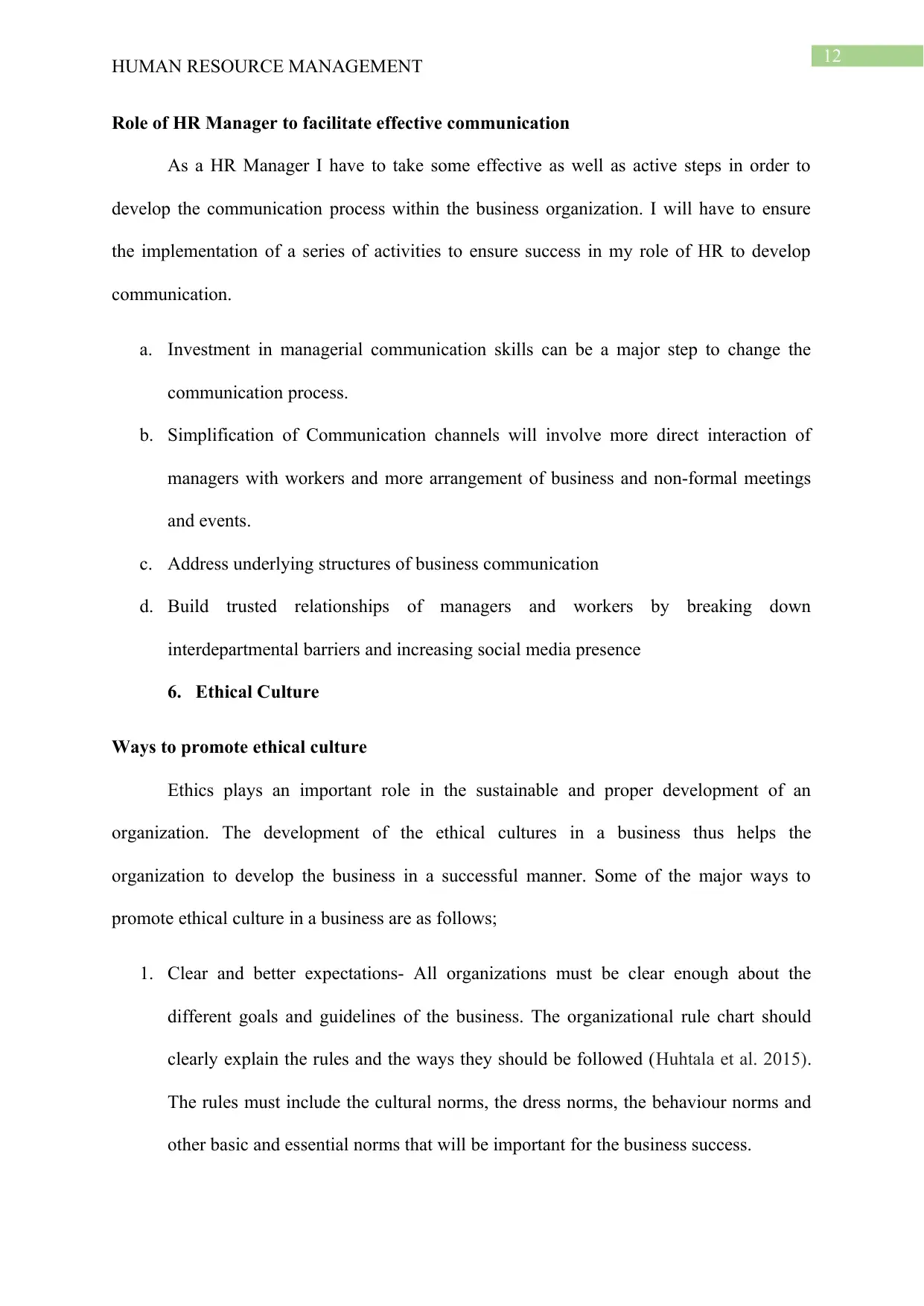
12
HUMAN RESOURCE MANAGEMENT
Role of HR Manager to facilitate effective communication
As a HR Manager I have to take some effective as well as active steps in order to
develop the communication process within the business organization. I will have to ensure
the implementation of a series of activities to ensure success in my role of HR to develop
communication.
a. Investment in managerial communication skills can be a major step to change the
communication process.
b. Simplification of Communication channels will involve more direct interaction of
managers with workers and more arrangement of business and non-formal meetings
and events.
c. Address underlying structures of business communication
d. Build trusted relationships of managers and workers by breaking down
interdepartmental barriers and increasing social media presence
6. Ethical Culture
Ways to promote ethical culture
Ethics plays an important role in the sustainable and proper development of an
organization. The development of the ethical cultures in a business thus helps the
organization to develop the business in a successful manner. Some of the major ways to
promote ethical culture in a business are as follows;
1. Clear and better expectations- All organizations must be clear enough about the
different goals and guidelines of the business. The organizational rule chart should
clearly explain the rules and the ways they should be followed (Huhtala et al. 2015).
The rules must include the cultural norms, the dress norms, the behaviour norms and
other basic and essential norms that will be important for the business success.
HUMAN RESOURCE MANAGEMENT
Role of HR Manager to facilitate effective communication
As a HR Manager I have to take some effective as well as active steps in order to
develop the communication process within the business organization. I will have to ensure
the implementation of a series of activities to ensure success in my role of HR to develop
communication.
a. Investment in managerial communication skills can be a major step to change the
communication process.
b. Simplification of Communication channels will involve more direct interaction of
managers with workers and more arrangement of business and non-formal meetings
and events.
c. Address underlying structures of business communication
d. Build trusted relationships of managers and workers by breaking down
interdepartmental barriers and increasing social media presence
6. Ethical Culture
Ways to promote ethical culture
Ethics plays an important role in the sustainable and proper development of an
organization. The development of the ethical cultures in a business thus helps the
organization to develop the business in a successful manner. Some of the major ways to
promote ethical culture in a business are as follows;
1. Clear and better expectations- All organizations must be clear enough about the
different goals and guidelines of the business. The organizational rule chart should
clearly explain the rules and the ways they should be followed (Huhtala et al. 2015).
The rules must include the cultural norms, the dress norms, the behaviour norms and
other basic and essential norms that will be important for the business success.
⊘ This is a preview!⊘
Do you want full access?
Subscribe today to unlock all pages.

Trusted by 1+ million students worldwide
1 out of 16
Related Documents
Your All-in-One AI-Powered Toolkit for Academic Success.
+13062052269
info@desklib.com
Available 24*7 on WhatsApp / Email
![[object Object]](/_next/static/media/star-bottom.7253800d.svg)
Unlock your academic potential
Copyright © 2020–2025 A2Z Services. All Rights Reserved. Developed and managed by ZUCOL.





